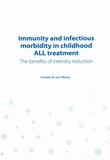Immunity and infectious morbidity in childhood ALL treatment
The benefits of intensity reduction

Tilburg, Cornelis van
- Promoter:
- Prof.dr. E.A.M. (Lieke) Sanders
- Co-promoter:
- Dr. M.B. (Mark) Bierings & dr T.F.W. (Tom) Wolfs
- Research group:
- Sanders
- Date:
- March 22, 2011
- Time:
- 16:15 h
Summary
With current childhood acute lymphoblastic leukemia (ALL) treatment protocols the cure rate approaches 90%. In the 10 percent of case fatalities, 2 major challenges stand out: incurable relapses of ALL and (infectious) deaths-in-remission. Thus, reducing toxicity is becoming an important goal to further improve childhood ALL survival. The Dutch Childhood Oncology Group (DCOG) ALL 10 protocol was designed to investigate whether a reduction of chemotherapeutic treatment intensity after a standard initial treatment phase is possible for patients with a good prognosis (standard risk; SR), based on minimal residual disease measurement, and whether further intensification of therapy improves the outcome for medium risk (MR) and high risk patients. We prospectively compared infectious complications and damage to the immune system during and following SR reduced versus conventional MR treatment. 171 patients (SR, 54; MR, 117) were included in the study on infectious morbidity. All parents of patients kept a daily log in which all episodes of fever were reported, which were systematically reviewed in the clinical files. SR reduced intensification/maintenance chemotherapy resulted in significantly less infectious morbidity compared with MR treatment. SR patients had significantly fewer febrile episodes and hospitalizations for fever compared with MR patients. In addition, infections of SR patients were less severe. Hospitalizations for fever were clustered mainly in the identical induction/HD-MTX phase, the first half of the MR intensification/maintenance phase but also the second half of the MR intensification/maintenance phase showed significantly more hospitalizations compared with the SR group. In a subgroup of patients, B and T cell subpopulations were analyzed during and after chemotherapy. Regarding lymphocyte subpopulations, transitional and naive B cells were more affected than memory B cell subpopulations, especially in the MR group. The IgG+/A+, IgM+ and IgM only memory B cells were significantly reduced during chemotherapy; significantly less in the SR group. One year after chemotherapy cessation, increased B cell numbers were found, consisting mainly of transitional and naive B cells while CD27+IgG+/A+, IgM+ and IgM only memory B cells had still not fully recovered. The T cell compartment was less but also significantly affected during chemotherapy. CD4+ T cells were most affected compared with CD8+ T cells although both recovered to normal ranges within 1 year after chemotherapy cessation. Immunoglobulin levels showed significantly different patterns between the SR and MR groups. In the MR group IgG, IgA and IgM levels decreased towards the end of treatment; in the SR group IgG levels increased during intensification/maintenance phase, while IgA and IgM stabilized. In both groups IgM and IgG levels were most affected. Specific antibody levels against diphteria, tetanus and B. pertussis all continued to decline in both groups. Still, SR treatment resulted in higher specific antibody levels than MR treatment. In conclusion, levels of T and B cell subpopulations together with immunoglobulin and specific antibody concentrations were less affected by reduced intensity chemotherapy which was, next to less frequent episodes of neutropenia, reflected in a major reduction in infectious morbidity. The beneficial effect of treatment reduction on specific antibody levels seemed only marginal.